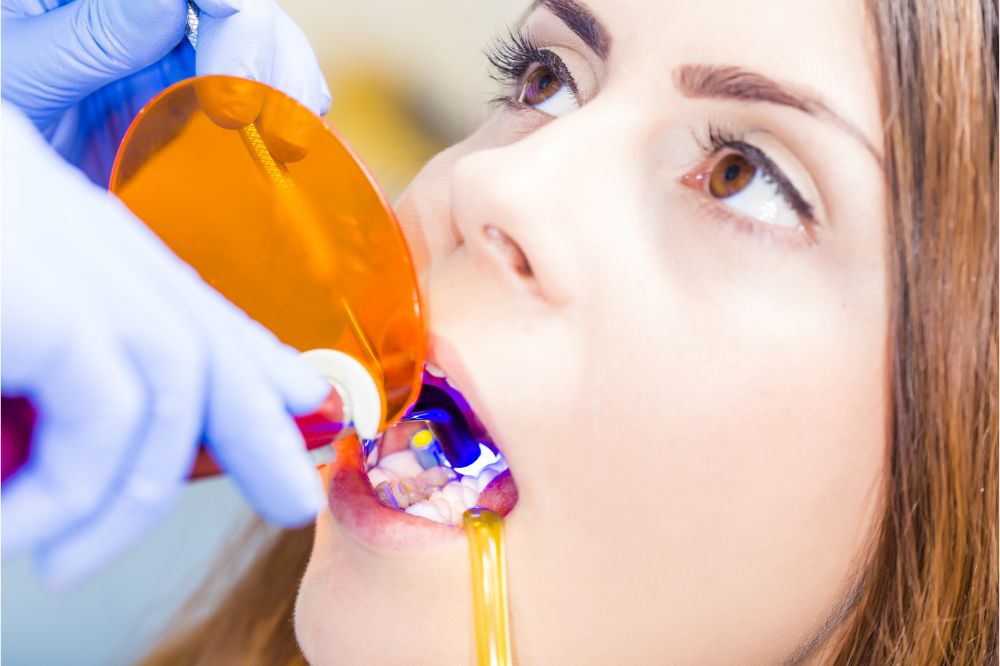Dental bonding is a common procedure that is often used to improve people’s smiles, but like most dental procedures, dental bonding won’t last forever.
Table of Contents
As a result, after your dental bonding, you’ll eventually have to return to your dentist for retouching or replacements – and to help you understand what to expect, in this post, we answer the question, how long does dental bonding last?
If you want to learn more about this procedure while getting a preview of some of the things we’re going to be talking about, you can watch this video before reading on.
How Long Does Dental Bonding Last? The short answer
Before we go into this topic in-depth, we can start with a short answer to a simple question.
How long does dental bonding last?
On average, you can expect dental bonding to last between three and ten years – and a more common range would be between four and eight years.
However, with the proper care, dental bonding can last even longer than ten years before you need to schedule an appointment for touch-ups or replacements.
So that’s the short answer, but here’s a lot more to this topic than just this – so now let’s jump in and look at the question in more detail.
What is dental bonding?
Let’s start at the beginning – what is dental bonding?
Dental bonding is a largely cosmetic procedure that’s used to fix a range of mostly aesthetic problems, helping to restore both the patient’s smile and their confidence.
The procedure involves using a tooth-colored composite resin that’s molded and bonded to teeth to fix chips, change the shape or length of teeth or improve the appearance of discolored teeth.
Dental bonding is among the most common cosmetic dental procedures and is popular due to how quickly it can be done, the relatively low cost and the fact that it’s a non-invasive procedure.
What problems can dental bonding fix?
Dental bonding is used mainly to improve the way teeth look.
It can be done to fill in chips or cracks in teeth, to fill in gaps and to resolve discoloration or staining.
Furthermore, it can also be used to fill cavities, cover old metal fillings, protect roots that have been exposed due to gum recession and protect an exposed part of the tooth.
Since it is a relatively quick and easy procedure to perform, it is preferable for more minor issues such as these rather than opting for something more invasive – and more expensive.
What’s the procedure?
Let’s break the procedure down into three stages, what happens before, during and after having dental bonding applied to your teeth.
-
Before
Before your dental bonding begins, you will consult with your dentist to confirm what you want to achieve through the procedure and how you want your teeth to look once the job is done.
Your dentist will then examine your teeth visually and through X-ray to ensure your teeth are healthy enough for the procedure to go ahead.
If your teeth are not in good enough condition for the procedure, your dentist may recommend other corrective procedures before the dental bonding can be done.
-
During
After the consultation phase, your dentist will start by choosing the correct shade for your teeth and confirming with you that it’s what you want.
After that, the surface of your tooth will be roughened slightly – without completely removing the enamel – and a conditioning liquid is applied to help the resin stick to your tooth correctly.
Next, your dentist will apply the resin, molding it into the correct shape. This is then cured through the use of a special tool that emits a type of light that causes the resin to harden.
Finally, the tooth is polished to make sure it looks as natural as possible.
-
After
After the procedure, your tooth is “ready to go” straight away. You can eat or drink anything you like as soon as you leave your dentist’s office.
However, you will need to make sure you take proper care of your tooth after the bonding to make sure it lasts as long as possible.
This will involve following good dental hygiene practices such as regular brushing and flossing as well as visiting your dentist for regular check-ups.
In the days following the procedure, you should pay attention to the affected tooth or teeth to make sure everything is as it should be.
If the tooth feels strange or misshapen or if there are any sharp edges, you may need to go back to see your dentist to have it touched up.
It’s normal to feel a little sensitivity for a day or two after the procedure, but if you experience excessive sensitivity in the tooth, or if it persists for more than just a few days, you should also contact your dentist to book a follow-up appointment.
What can affect how long dental bonding lasts?
At the start of this post, we said that you can usually expect dental bonding to last in the range of three to ten years before you need to go for a touch-up or a replacement. However, there’s a lot you can do to help ensure it lasts as long as possible.
Here are some of the most important things to remember
1. Follow dental hygiene best practices
As with most dental interventions, the most important thing you can do to ensure the long-term success of the procedure is to always follow dental hygiene best practices.
This means brushing regularly – and using a non-abrasive toothpaste and a soft-bristled brush will also help. Flossing daily is also an important part of caring for your teeth.
You should also see your dentist for regular check-ups to help nip potential problems in the bud before they become more serious, and you should also go for dental cleaning twice a year.
2. Ensure no food gets stuck in the tooth
When eating, try to make sure no food becomes stuck in the tooth the resin was applied to. If your food gets stuck, try to remove it carefully rather than yanking it out or poking it too vigorously with a toothpick.
3. Resist bad habits
Certain bad habits like chewing your fingernails or chewing the end of pens should be avoided as they will place the tooth under unnecessary stress. Smoking is also to be avoided since it weakens your gums and can also stain a tooth with dental bonding.
4. Don’t use your teeth as tools
Don’t use your teeth as tools for opening things like bottles or packages.
5. Avoid staining food and drinks
Certain foods and drinks like red wine, coffee, tea and curry can also stain your teeth. You might not want to give them up entirely, but limiting their consumption will mean your tooth takes longer to become stained.
6. Avoid excessively hard or chewy foods
Although dental bonding allows you to continue to eat normally, you might prefer to avoid certain foods such as hard candy or chewy foods since these can damage the resin, or they could pull the resin off your tooth.
FAQs
What’s the difference between bonding and veneers?
People often wonder about the difference between bonding and veneers, and while bonding is a non-invasive and fully reversible process, having veneers fitted involves removing the enamel from the front of your teeth and adding porcelain covers.
Veneers are stronger and will last longer – perhaps as long as ten to 20 years – but the process is not reversible and is considered more invasive.
If you want to learn more about bonding vs veneers, you can check out this video.
How long does dental bonding usually take?
The process usually takes around 30 minutes to an hour from start to finish.
Does dental bonding hurt?
Dental bonding is a non-invasive process that shouldn’t be painful. The dentist usually won’t need to work anywhere close to the nerves in your teeth or mouth, so local anesthetic is usually not even required.
How long after dental bonding do you have to wait before you can eat?
After the process has been completed, your teeth are ready to go. You don’t need to wait for the resin to set since it will have already been cured as part of the process – so you can go out and have something to eat or drink right away.
What else can affect how long the bonding lasts?
Other than the factors you can control such as your dental hygiene, your diet and your lifestyle habits, there are certain other factors that can affect how long dental bonding can last.
For example, the quality of the material can vary, and higher-quality resin will usually last longer.
The location of the bonding will also significantly impact how long the bonding lasts.
If the bonding is on the side of a tooth, it will usually last a lot longer than bonding on the parts of teeth that are used for chewing or biting.
Proper care can increase the lifespan
As we explained, you can expect your dental bonding to last anywhere between three and ten years, or even longer if you’re lucky.
If you want to increase the likelihood of your bonding reaching the upper end of this limit, there’s a lot you can do, including paying proper attention to your dental health, avoiding certain foods and not engaging in bad habits like finger-chewing or pen-biting.

